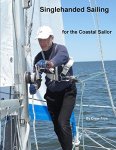thinwater
Well-Known Member
A hundred thoughts come to mind. I've recorded many here:

https://amzn.to/2s7EwpN
* Autopilots are great, but also practice adjusting the boat to hold a course by set of sail alone. For example, jib in tight and traveler down should hold a close reach.
* Practice emergency steering with a drogue (can be fenders and anchor). I've had a bent rudder solo (submerged tree trunk) and it helps if you've sorted this out ahead of time. Failed is one of the more common reasons for vessel abandonment, but it should not be.
* Anchoring out is a better choice than a difficult docking situation.

https://amzn.to/2s7EwpN
* Autopilots are great, but also practice adjusting the boat to hold a course by set of sail alone. For example, jib in tight and traveler down should hold a close reach.
* Practice emergency steering with a drogue (can be fenders and anchor). I've had a bent rudder solo (submerged tree trunk) and it helps if you've sorted this out ahead of time. Failed is one of the more common reasons for vessel abandonment, but it should not be.
* Anchoring out is a better choice than a difficult docking situation.
